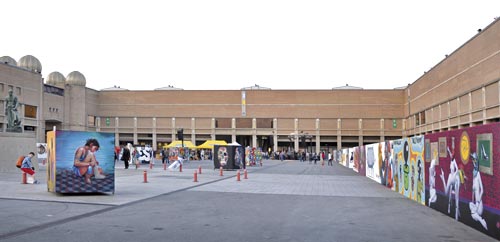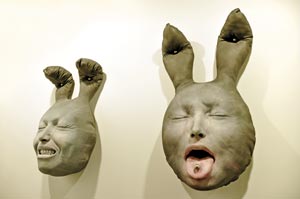The fifth edition of the young fair on emerging art, Swab, was held in Barcelona on May 23 - 26. You might think that the saturated program of fairs, the galloping economic crisis and the proximity of Madrid would stop the appearance of a new event of this kind in Spain. Nevertheless, Swab has resisted and has grown stronger with its small fair format, a platform for young international galleries that bet on emerging art and collecting. Founded in 2006 by Catalonian architect and collector Joaquin Diez-Cascon in order to showcase novel artistic proposals that had no visibility within the narrow circuit of institutions and museums, the latest edition reveals triumphant results, according to the statistics: its first edition was attended by 42 galleries, and it presently receives 64 international galleries from 20 different countries.
One of its goals is to promote collecting, and that’s the reason why prices fluctuate between 60 and24.000 €, the last one corresponds to a picture taken by Brazilian artist Caio Reisewitz, followed by Polish Aleksandra Mir’s marker drawing on paper, both represented by Joan Prats gallery. The serial-artwork vending machine was one of the new elements, specially created for this fair: Vending Art Machine. The price of artworks, which could be bought as any other article sold by the machine, didn’t surpassed 150 €, and the collaborations were linked to emerging artists represented in the event: Ion Macareno (Galeria Nuble), Juan Zamora (art nueve), Joan Salo (Galeria N2), Berto Martinez (Pantocrator Gallery), among others.
There’s no doubt that the model of contemporary art fair is being reinvented, and the appeal of these shows doesn’t exclusively lies on exhibiting fine art, but on the event as such, with its “seasoning” of commissioned sections, talk program and conferences, public art, screenings, etc. Initiatives such as Sunday, organized at a London hangar by galleries Limoncello (London), Croy Nielsen (Berlin) and Tulips and Roses (Berlin); Art-O-Rama from Marseille, where the market activity is centralized during the first days and, afterwards, the fair lasts longer as an exhibition; or the case of VIP Art Fair, the incursion of the art show on web 2.0; confirm that the format is being reviewed.
 The meeting of young art at the Montjuïc is not far from the classic fair despite it premiered projects such as the one at Univers square, creating a gathering and exchange space among Catalonian graffiti artists, DJ´s and independent music groups. This was the third time MYFAF (My First Art Fair) was presented, a section where four galleries, which have been handpicked by an expert committee, exhibit artworks for free; thus expressing the commitment of organizers when it comes to supporting and encouraging the participation of young spaces. This year’s galleries were Junge Kunst (Berlin), La Bañera Gallery (Madrid), MUTT (Barcelona) and Zak Gallery (Siena). The theoretical “seasoning” was articulated through the debuting section, Talking Artist, a cycle of talks in which five commissioners shed light, via Skype or live, on the work of some creators that attended the event.
The meeting of young art at the Montjuïc is not far from the classic fair despite it premiered projects such as the one at Univers square, creating a gathering and exchange space among Catalonian graffiti artists, DJ´s and independent music groups. This was the third time MYFAF (My First Art Fair) was presented, a section where four galleries, which have been handpicked by an expert committee, exhibit artworks for free; thus expressing the commitment of organizers when it comes to supporting and encouraging the participation of young spaces. This year’s galleries were Junge Kunst (Berlin), La Bañera Gallery (Madrid), MUTT (Barcelona) and Zak Gallery (Siena). The theoretical “seasoning” was articulated through the debuting section, Talking Artist, a cycle of talks in which five commissioners shed light, via Skype or live, on the work of some creators that attended the event.
American Galleries section showcased Latin American art that was put on the map by galleries from Argentina (Artis Arte Contemporaneo, Document Art, Pabellon 4 Arte Contemporaneo), Mexico (Lacoope Gallery, The New Wall Gallery), Colombia (La Nueva Galeria, LEM Art Gallery) and Chile (Die Ecke Arte Contemporaneo). Likewise, the collaboration with SP-Arte fair promoted the participation of galleries from São Paulo and Rio de Janeiro.
In six years, the fair has given giant steps toward its objectives; nevertheless, it’s still far from attracting galleries that showcased truly progressive proposals, as well as having the "emerging art fair" slogan positioned beyond the youth of exhibitors. Another phenomenon that attempts against the stability of the event is the dithyrambic participation of foreign galleries. Spanish galleries are to hold their position, but foreign galleries find it hard to do after doing their math back home.
 What did we see in Swab? A lot of tow-dimensional art, drawings, engravings, paintings and pictures, sculptures and small-format installations. The new media was absent, which is understandable if you take into account that many of these galleries used to participate in Loop video-art fair, one week after in Barcelona. Raiña Lupa’s booth stood out with Jordi Mitjà’s and Mar Arza’s works; ADN with the presence of Cuban Adrian Melis and his dream installation; MasArt with Alberto Peral’s and Sabine Finkenauer’s pieces; Galeria Nuble with works of Eduardo Hurtado; Die Ecke Arte Contemporaneo with the dialogue among Johanna Unzueta, Isidora Correa and Francisca Benitez; and Halfhouse space.
What did we see in Swab? A lot of tow-dimensional art, drawings, engravings, paintings and pictures, sculptures and small-format installations. The new media was absent, which is understandable if you take into account that many of these galleries used to participate in Loop video-art fair, one week after in Barcelona. Raiña Lupa’s booth stood out with Jordi Mitjà’s and Mar Arza’s works; ADN with the presence of Cuban Adrian Melis and his dream installation; MasArt with Alberto Peral’s and Sabine Finkenauer’s pieces; Galeria Nuble with works of Eduardo Hurtado; Die Ecke Arte Contemporaneo with the dialogue among Johanna Unzueta, Isidora Correa and Francisca Benitez; and Halfhouse space.
Swab is a fair that responds to the needs of the present artistic panorama, with refreshing formats, decentralized, that target the creation and management of emerging arts. One of the conflicts faced in terms of its organization is how to promote and attract collectors with similar interests… how to boost, even in that Catalonian city, the need to visit the fair. These are hard times, and resisting the fluctuation of the current economy is already a victory, growing such as Swab has done it in just a few years is kind of encouraging. Let’s augur a better upcoming edition, more rigorous when it comes to choosing galleries and projects, risky in formats and perseverating on providing support for emerging art, with its positive and negative elements.
July, 2012
Related Publications

How Harumi Yamaguchi invented the modern woman in Japan
March 16, 2022
Giovanni Duarte and an orchestra capable of everything
August 26, 2020











